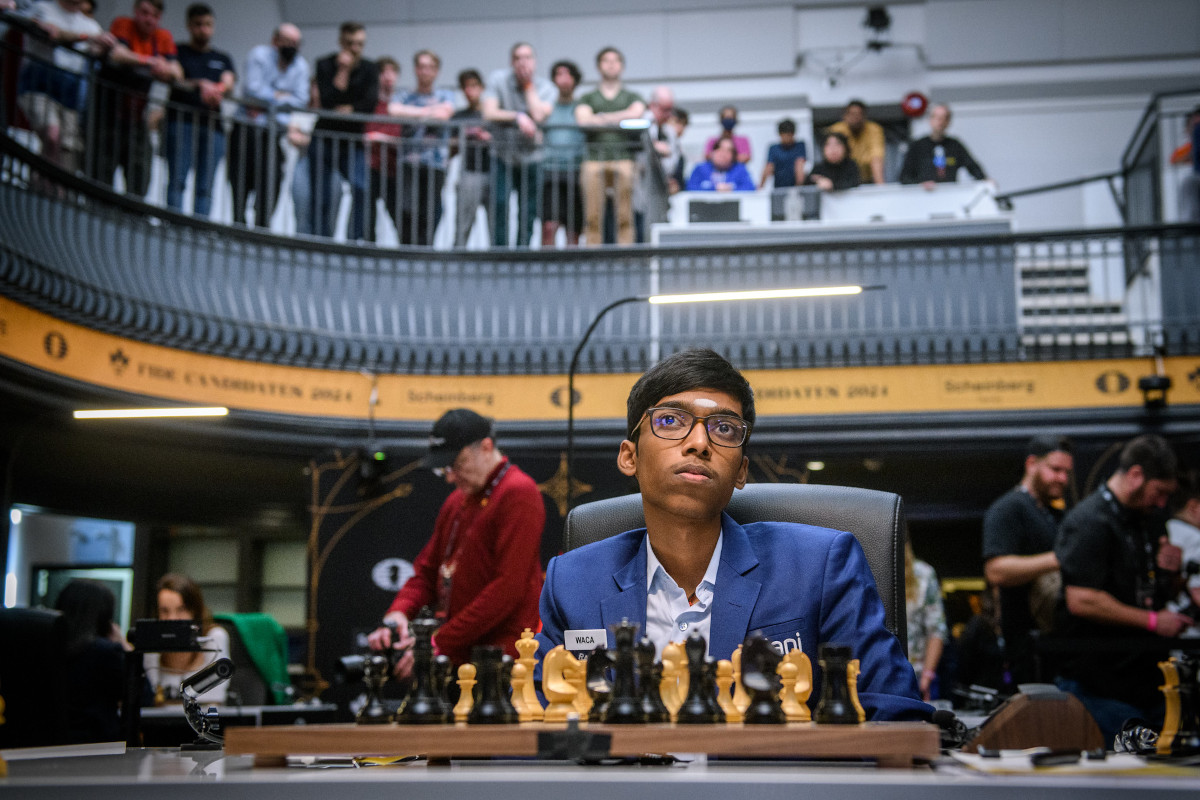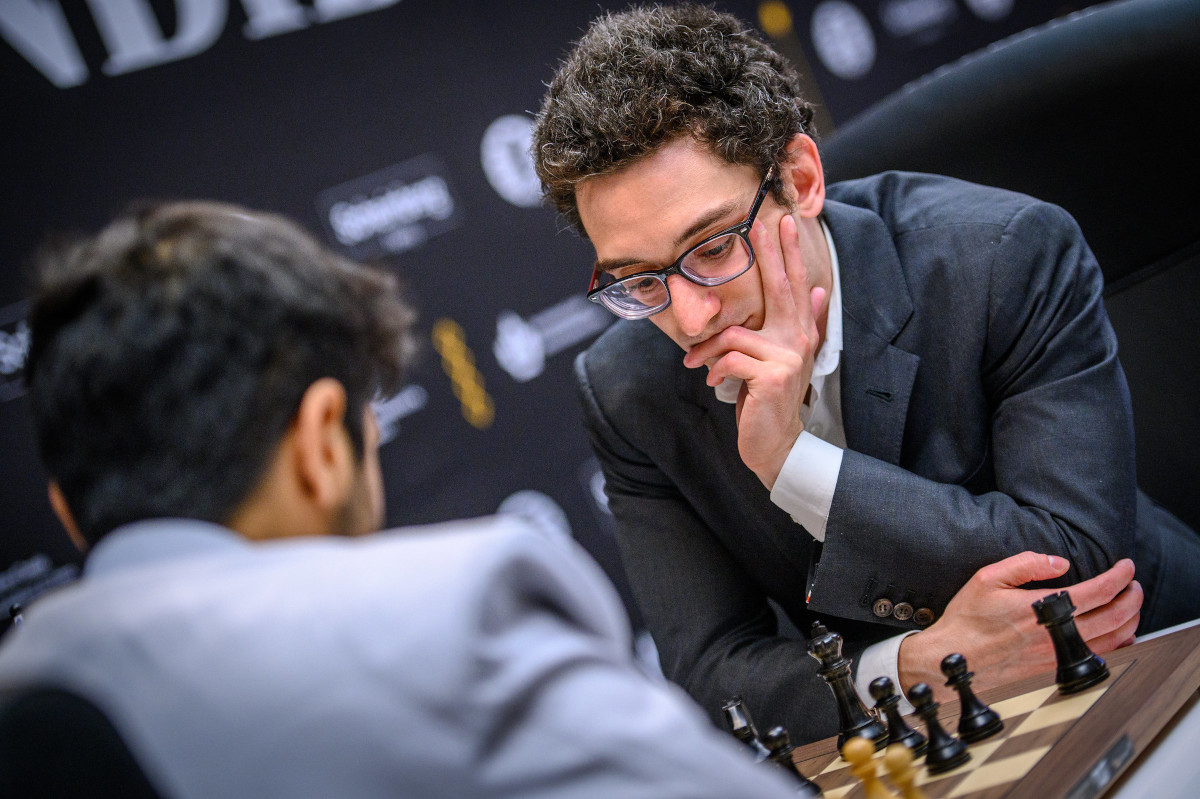


The Candidates continue to entertain chess fans all over the world with exciting, hard-fought games. Round 5 saw Praggnanandhaa R playing a strong opening idea against Ian Nepomniachtchi; Vidit Gujrathi failing to make the most of Fabiano Caruana’s over-optimistic play; Alireza Firouzja faltering in an endgame to lose against Hikaru Nakamura; and Gukesh D first mishandling a superior position and then beating Nijat Abasov in a queen endgame.
As the round-5 encounters reached the middlegame phase, it seemed likely for Pragg to inflict a first defeat on Nepo after employing a formidable piece of preparation, while Vidit suddenly got big winning chances once Caruana faltered by missing a tactical idea in a double-edged position. Not long after, both games ended drawn.
By that point, Gukesh had obtained a strategic, stable advantage over Abasov, while the game between Firouzja and Nakamura was the most balanced confrontation, with both contenders showing proficient play in an interesting middlegame. Much later in the day, both encounters ended decisively, as Firouzja and Abasov faltered in technical endgames.
Once the action was over about six hours into the round, Gukesh emerged as co-leader. After beating Abasov, the Indian prodigy is tied for first with Nepomniachtchi, each with 3½ points.
In Wednesday’s sixth round, Nepo and Gukesh will play white against the top two seeds in the tournament — Caruana and Nakamura, respectively.
Results - Round 5

Italian tenor Andrea Bocelli visited the tournament hall and played a chess game against none other than Vishy Anand — with the black pieces! | Photo: FIDE / Michal Walusza
For a fifth game in a row, Pragg showed remarkable opening preparation. Facing Nepo’s Petroff Defence, the 18-year-old blitzed out his first 20 moves confidently, entering a line involving a couple of pawn sacrifices.
Only after 19.d5 did Nepo seem to be out of book (or perhaps he was reviewing the lines he had prepared in his head) — the Russian had also blitzed out all his moves up to this point, but he spent 40 minutes before playing 19...cxd5.
Pragg quickly continued with 20.Ng5, to which Nepo replied with the imprecise 20...h6 after thinking for 8 minutes (20...g6 was stronger).
Then came the energetic 21.Nxf7, played by Pragg after less than 2 minutes!
After 21...Kxf7, White was a piece down, but he had played fearless, bold chess to amass both a 50-minute advantage on the clock and a clear psychological edge.
As the commentators expected, Nepo gave back material looking to deal with his opponent’s threats. However, after 21...Kxf7 22.Rd3 Nd7 23.Rxd5, the Russian faltered with 23...Nc5
Instead of the knight jump, Black needed to play 23...Bxh2, the one move that kept the dynamic balance.
The next critical point was reached after 24.Rxd6 Kg8 25.Qd5+ Kh8
With 1 hour and 26 minutes on his clock, Pragg spent around 12 minutes before playing 26.Bf5 here, when 26.Qe5 (or the less precise 26.Qd4) was the way to keep his advantage, pinning the g-pawn and thus creating the threat of an eventual Rxh6+.
After 26...Nb7, White’s best continuation is to swap the queens with 27.Qxa5 Nxa5. Nepo had survived the opening scare, and then showcased his usual quick, confident style to keep the balance and eventually sign a 44-move draw.

Excellently prepared — Praggnanandhaa Rameshbabu | Photo: FIDE / Michal Walusza
Much like Pragg, Vidit has been displaying audacious opening ideas throughout the event in Toronto. On Tuesday, though, the 29-year-old faced one of the strongest theoreticians in the world, and had to spend close to 20 minutes already on move 7.
The Indian star nonetheless handled the opening stage formidably, entering a position with opposite-side castling which engines soon evaluated as slightly favourable for White.
And, on move 22, Caruana decided not to castle short (which was the strongest move in the position) and go for 22...e5 instead, as he failed to foresee that 23.Qg3, as played by Vidit, would leave him in a really tough spot.
Caruana counted with 23...Qa7, going all-in on the queenside while allowing his opponent to play 24.Qxe5, pinning the e7-bishop and preventing Black from castling short.
Fortunately for Caruana, however, Vidit had about 12 minutes on his clock at this point (with 26 moves to go). After 24...Rxa2 25.Qg7 Rf8, the Indian grandmaster decided to enter a line that led to a draw by perpetual check.
If Vidit had more time on his clock, he would have probably tried to assess the positions arising after moves like 26.Kc1 or 26.Kc2 (which are winning for White), but given the time situation and perhaps because he came from losing two games in a row, he went for 26.Qe5 Qa4 27.Qb8+ Bd8 28.Qe5+ Be7 instead.
A draw by repetition following an exciting battle! Note that Black is threatening to give checkmate on a1.

Fabiano Caruana | Photo: FIDE / Michal Walusza
This game featured a rich strategic struggle out of a Giuoco Piano, with both players handling the tension remarkably and only trading queens on move 41.
An imbalanced yet equal endgame with two rooks and a minor piece per side was eventually reached, as a draw continued to be the expected result going forward.
Suddenly, however, Firouzja entered a forcing line, which surprised commentator Irina Krush, who considered 53.f6+ to be unnecessarily risky.
Here 53.Rxd4 Nxd3 54.Rxd3 Rxf5 55.Re2 further simplifies matters, and is to lead to a somewhat quick draw agreement.
After the text, on the other hand, a forcing sequence resulted in Nakamura getting a knight and two pawns for a rook, with the black king quite active on f5. The position was still balanced, but the U.S. grandmaster was surely given a chance to pose tricky questions to his young opponent.
Firouzja’s decisive mistake came on move 62.
The white king and rook need to find a way to simultaneously deal with the two black passers, on the d and g-files (and the h-pawn is also coming). Moves like 62.Ra8 or 62.Rd8 maintain the equality here, while 62.Kxd3, as played by Firouzja, loses rather quickly.
Nakamura had no trouble finding 62...g3 63.Rf8 Ke6
The white king cannot defend against ...g3-g2-g1 as the knight defends the promotion square from h3, while 64.Rg8 fails to 64...g2 65.Rxg2 Nf4+, with a deadly fork. Firouzja resigned before seeing these moves appear on the board.
A painful defeat for the 20-year-old representing France, who now stands a full 2 points behind the co-leaders.

Alireza Firouzja v. Hikaru Nakamura | Photo: FIDE / Michal Walusza
The last encounter to end on Tuesday saw Gukesh failing to take advantage of a clear strategic edge in the middlegame, only to (much later) win the game after Abasov erred in a drawn queen endgame.
By move 35, most commentators predicted that Gukesh would convert the following position into a full point.
White is a pawn, has the safer king, and it seems like his coordinated army will not have much difficulty in dealing with the passer on the d-file.
However, a good defensive effort by Abasov and a couple of imprecisions by Gukesh led to a queen endgame with an extra pawn for White — one that tablebases proved to be drawn with perfect play.
Abasov continued to show good defensive skills, but Gukesh was not going to stop trying until a completely forced draw would be reached. In the end, the Indian’s perseverance was rewarded, as his opponent erred decisively with 83...Qf1+
The one move that would have kept the balance was 83...Qg2 — after the text, White’s winning idea is not difficult to find for a player of Gukesh’s calibre (commentator Vishy Anand saw it immediately).
There followed 84.Qf4 Qb5+ 85.Qe5, and Abasov realized what had just happened.
Any check will be followed by a counter (discovered) check — and White will be able to force a queen trade in any reasonable line. Resignation came after 85...Qd7+ 86.Kf6+ Kh4 87.Qg5+
87...Kh4 88.Qf5+ and White will convert his extra pawn into a trivial win. A tough loss — after a valiant defensive effort — for Abasov.

Nijat Abasov | Photo: FIDE / Michal Walusza
Watch tons of high-quality content on ChessBase India’s YouTube channel!
| Advertising |